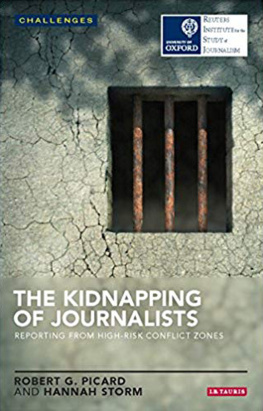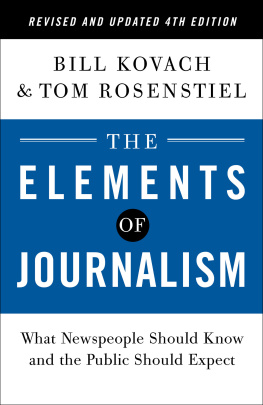Routledge Library Editions: Journalism
Volume 13
VIDEOTEX JOURNALISM
Videotex Journalism
Teletext, Viewdata, and the News
David H. Weaver
First published in 1983
This edition first published in 2016
by Routledge
2 Park Square, Milton Park, Abingdon, Oxon OX14 4RN
and by Routledge
711 Third Avenue, New York, NY 10017
Routledge is an imprint of the Taylor & Francis Group, an informa business
1983 Lawrence Erlbaum Associates, Inc.
All rights reserved. No part of this book may be reprinted or reproduced or utilised in any form or by any electronic, mechanical, or other means, now known or hereafter invented, including photocopying and recording, or in any information storage or retrieval system, without permission in writing from the publishers.
Trademark notice : Product or corporate names may be trademarks or registered trademarks, and are used only for identification and explanation without intent to infringe.
British Library Cataloguing in Publication Data
A catalogue record for this book is available from the British Library
ISBN: 978-1-138-80197-4 (Set)
ISBN: 978-1-315-68235-8 (Set) (ebk)
ISBN: 978-1-138-92133-7 (Volume 13) (hbk)
ISBN: 978-1-315-68245-7 (Volume 13) (ebk)
Publisher's Note
The publisher has gone to great lengths to ensure the quality of this reprint but points out that some imperfections in the original copies may be apparent.
Disclaimer
The publisher has made every effort to trace copyright holders and would welcome correspondence from those they have been unable to trace.
VIDEOTEX JOURNALISM
Teletext, Viewdata, and the News
David H. Weaver
Copyright 1983 by Lawrence Erlbaum Associates, Inc.
All rights reserved. No part of this book may be reproduced in any form, by photostat, microform, retrieval system, or any other means, without the prior written permission of the publisher.
Lawrence Erlbaum Associates, Inc. Publishers
365 Broadway
Hillsdale, New Jersey 07642
Library of Congress Cataloging in Publication Data
Weaver, David H. (David Hugh), 1946
Videotex journalism.
Bibliography: p.
Includes index.
1. Journalism-Data processing. 2. Videotex (Data transmission system) 3. Teletext (Data transmission sys tem). I. Title.
PN4784.ESW4 1983 070'.028'5 82-21094
ISBN 0-89859-263-1
Printed in the United States of America
10 9 8 7 6 5 4 3 2 1
To Gail, Quinn, and Lesley
-Who put up with the most.
Contents
The idea for this study of the impact of videotex technology on journalists and the news came from readings and discussions with several colleagues at Indiana University's School of Journalism during the spring and summer of 1979, as well as from my own interest in the broader effects of technology on journalism, originally spurred by Donald Shaw at the University of North Carolina ten years ago. Prompted by the interest of certain of my Indiana associates in the coming teletext and viewdata systems (most notably John Ahlhauser, George Alexander, and Timothy Stehle) and the concern by others about the effects of changing technology on journalism (Walter Jaehnig, Cleve Wilhoit, and Richard Gray in particular), I began to consider ways to study the likely effects of the newly emerging videotex technology on journalism.
Although nearly all previous studies of the effects of technology on both journalism and the larger society were done long after the introduction of the technology (understandably!) and after its uses had become firmly established, it seemed worthwhile to try to assess some of the most likely major effects of an emerging technology not yet widely diffused, in the hope (perhaps naive) that the results of such a study might influence the ways in which this technology eventually would be employed.
While research on technological and marketing aspects of electronic delivery systems is necessary if such systems are to be developed and widely used, it is also extremely important to ask what effects such systems are having, or are likely to have, on the way journalists perform their jobs and on what comes to be defined as news. As H. M. Greenspun, publisher of the Las Vegas Sun, put it:
England was the logical site for a study of the effects of videotex on journalism and the news because the Ceefax (BBC) and Oracle (lTV) teletext systems have been operating as full-fledged public news and information services longer than anywhere else in the English-speaking world (since 1974 for Ceefax and 1975 for Oracle). In addition, another system operated by the Post Office (British Telecomm) since 1979links individual television sets to a computerized information bank via telephone lines and thus enables the viewer to interact with the system. This viewdata system, known as Prestel, offers more than 180,000 "pages" (TV screens or frames) of information from more than 500 information providers (mostly businesses of various kinds). More discussion on these systems follows in .
By comparison, the United States and other countries have been well behind the United Kingdom in the development and use of both teletext and viewdata. In addition to Britain's advantage over other countries in experience with real public videotex systems, the country is an especially suitable research setting for studies of national media organizations and journalists because of its centralized media patterns and relatively small geographic area. All of the public teletext and viewdata systems in the country are based in London, as well as the television networks and national newspapers.
Another great advantage of having England as a base for a study such as this is the presence of such mass communication scholars as Jay Blumler, director of the Centre for Television Research at the University of Leeds; Peggy Gray, Philip Elliott, and James Halloran of the Centre for Mass Communication Research at the University of Leicester; Jeremy Tunstall of The City University in London; and Michael Gurevitch of The Open University, to name just a few. Jay Blumler generously provided office space in his Centre and helped arrange housing in Leeds during my stay there from January until May of 1981. He introduced me to executives working for the British Broadcasting Corporation, the Independent Television Network, and the Post Office's Prestel viewdata system. His sound advice on a wide ranging array of matters was absolutely essential to the completion of this study, and his reactions to some of the early drafts greatly improved this report. In addition, his friendship made the transition from the New World to the Old much easier and more pleasant.
In Leicester, Peggy Gray and James Halloran generously provided a copy of their extensive study of Prestel users in Swindon and Norwich, and Philip Elliott spent considerable time going over computer printouts from his na tional survey of nearly 400 journalists. Peter Golding kindly invited me to conduct a seminar on what I had found up to the time of leaving England, and several persons attending made helpful suggestions.







